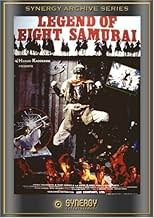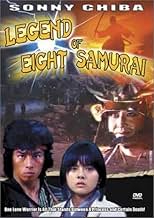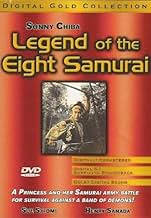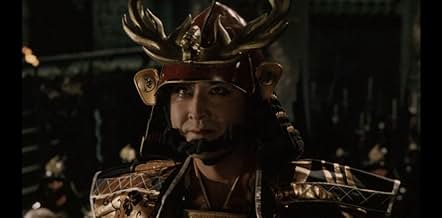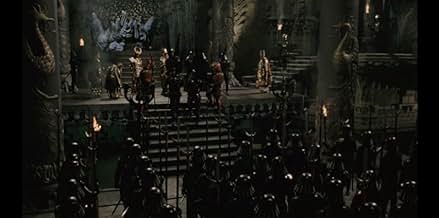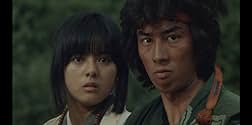Satomi hakken-den
- 1983
- 2h 13m
ÉVALUATION IMDb
6,4/10
1,5 k
MA NOTE
Ajouter une intrigue dans votre languePrincess Shizu was born under a terrible curse. Only the eight legendary samurai, hailing from across Japan, can protect her from an ancient supernatural clan to fulfill their destinies as f... Tout lirePrincess Shizu was born under a terrible curse. Only the eight legendary samurai, hailing from across Japan, can protect her from an ancient supernatural clan to fulfill their destinies as foretold by prophecy.Princess Shizu was born under a terrible curse. Only the eight legendary samurai, hailing from across Japan, can protect her from an ancient supernatural clan to fulfill their destinies as foretold by prophecy.
- Director
- Writers
- Stars
- Prix
- 4 nominations au total
Shin'ichi Chiba
- Inuyama Dosetsu Tadatomo
- (as Sonny Chiba)
Kenji Ôba
- Inukai Genpachi Nobufuchi
- (as Kenji Ohba)
Keiko Matsuzaka
- Princess Fuse
- (voice)
Avis en vedette
Every once and awhile (Normally among the younger generation, such as myself) you will see a movie and think "Wow, every movie I have ever SEEN has stolen ideas from this!" You will probably be overjoyed, having finally found that one adrenaline pounding action flick that you've always searched for. Thats how I felt when I first saw "Yojimbo" anyway. "BUT!", you say, "this isn't about "Yojimbo"! You need to explain the "Legend of the Eight Samurai"!" And indeed I do, but first, the comparison has to be made. If "Yojimbo" is the movie that every martial arts director has in some way emulated, "Legend of the Eight Samurai" ("LOTES") is the movie that every Japanese made videogame has, in some way, borrowed from. Stop reading if you want to be surprised, but I will present the partial list of comparisons between this film and classic videgames.
Plot Summary: There are a group of warriors (Almost any videogame) who possess Eight Glowing Crystals (The original final fantasy, other crystal-heavy games) which must save a Princess (Mario, Zelda, Lolo, etc.) from an Evil Evil Demonically Resurrected Warlord With Weird Magic Monster Stuff (Castlevania, Final Fantasy, etc.). Along the way, an unlikely hero (almost every videogame ever) will enlist the help of a Ninja Assassin (any videogame from the 80's), the One Bad Guy Who Turns Good at the Last Minute(any Final Fantasy Game), the One Guy Who Can Somehow Use Gunpowder(any Fantasy Setting Game), the Young Boy(every game from Pokemon to Zelda). In the course of the movie, the heroes will fight a giant centipede (everything from Abraxis to Zelda), miracously cure all of their wounds with only One Night of Sleep (EVERY game). Actually defeating the final badguy requires the life sacrifice of many characters (Most games), one Ultimate Powerful Bow and Arrow that was forged by good for, well, I don't really know (Zelda), and the ending has the credits roll while a confusingly translated Japanese Pop song plays.
Now, that may have sounded funky, but you REALLY have to see this. If you aren't convinced already, here's one more incentive: it has Sonny Chiba! If you've never heard of Chiba, you should look into his work. The goriness (and hillarity!) cannot be done with more attention to detail than in a Chiba movie.
I started watching this movie because of Chiba. I kept watching because of the Big Freaking Centipede. In the end, I felt like I understood the source of every videogame and anime plot since 1975. You should see this movie even if you don't play videogames. At the least, you'll find it entertaining for the action sequences and the occasionally (And suprisingly well translated) bits of dialogue.
Plot Summary: There are a group of warriors (Almost any videogame) who possess Eight Glowing Crystals (The original final fantasy, other crystal-heavy games) which must save a Princess (Mario, Zelda, Lolo, etc.) from an Evil Evil Demonically Resurrected Warlord With Weird Magic Monster Stuff (Castlevania, Final Fantasy, etc.). Along the way, an unlikely hero (almost every videogame ever) will enlist the help of a Ninja Assassin (any videogame from the 80's), the One Bad Guy Who Turns Good at the Last Minute(any Final Fantasy Game), the One Guy Who Can Somehow Use Gunpowder(any Fantasy Setting Game), the Young Boy(every game from Pokemon to Zelda). In the course of the movie, the heroes will fight a giant centipede (everything from Abraxis to Zelda), miracously cure all of their wounds with only One Night of Sleep (EVERY game). Actually defeating the final badguy requires the life sacrifice of many characters (Most games), one Ultimate Powerful Bow and Arrow that was forged by good for, well, I don't really know (Zelda), and the ending has the credits roll while a confusingly translated Japanese Pop song plays.
Now, that may have sounded funky, but you REALLY have to see this. If you aren't convinced already, here's one more incentive: it has Sonny Chiba! If you've never heard of Chiba, you should look into his work. The goriness (and hillarity!) cannot be done with more attention to detail than in a Chiba movie.
I started watching this movie because of Chiba. I kept watching because of the Big Freaking Centipede. In the end, I felt like I understood the source of every videogame and anime plot since 1975. You should see this movie even if you don't play videogames. At the least, you'll find it entertaining for the action sequences and the occasionally (And suprisingly well translated) bits of dialogue.
Satomi Hakkenden will be understood the moment the viewer realizes that the soulful, classically Japanese score is being played on a cheap Casio synthesizer, and that somehow that is good. Being one of the country's very traditional legends (stolen from China), the writers drew from literary sources to make their movie, and it shows. The movie has heaping doses of melodrama, decapitations, and dead children. It also has characters dressed like a costume shop exploded, giant flying snakes hanging by ropes, a truly terrible 70's power ballad love song, and a plot so stereotypically Japanese it can be considered prototypical.
None of that is to say that the movie is bad. All of those things add to the ambiance of the movie. It also contains incredible special effects for 1983, some of the moments are surprisingly poignant, and the fight scenes are great. The plot may be telegraphed from a mile away, but it is still entertaining to watch it all unfold. If you are at all a fan of Japanese culture, you have seen this movie before, in one way or another. Yet if this sounds at all appealing to you, you owe it to yourself to see the original. Satomi Hakkenden deserves a larger spot in great camp history.
None of that is to say that the movie is bad. All of those things add to the ambiance of the movie. It also contains incredible special effects for 1983, some of the moments are surprisingly poignant, and the fight scenes are great. The plot may be telegraphed from a mile away, but it is still entertaining to watch it all unfold. If you are at all a fan of Japanese culture, you have seen this movie before, in one way or another. Yet if this sounds at all appealing to you, you owe it to yourself to see the original. Satomi Hakkenden deserves a larger spot in great camp history.
This is not a bad movie by any means. It's a good story and the acting isn't as bad as some people indicate. The movie does suffer from a big 80's "new wave" influence and the English dub is horrible. I gave up on that version after 10 minutes. However, watching the remastered HD 16x9 version in Japanese with English subs made this actually an enjoyable movie.
LEGEND OF THE EIGHT SAMURAI (1983) is a live-action Japanese costume fantasy retelling the oft-told tale of eight warriors identified by their receipt of magic crystal balls sent by a long-dead princess to insure protection of her descendants. Here, the eight warriors who receive the crystal balls come together to protect the fugitive Princess Shizu of the Satomi Clan, which has been all but wiped out by the supernatural descendants of the Hikita Clan. The action is larded with fantasy elements, including a couple of monsters (a giant centipede and giant snake) and the long-lived evil matriarch Tamazusa (Mari Natsuki) who stays alive a hundred years after her 'death' at the hands of the Satomi Clan by taking special baths in blood.
Despite the title, there's no mention of samurai in the film's English-dubbed dialogue. The characters refer to each other as ninjas, even though few ninja costumes or accessories are visible. It's an unwieldy film with over a dozen major characters, none of whom take center stage until well past the film's half-way mark. The main focus of the plot is the gathering of the eight warriors as they meet and realize their destiny to protect the princess and attack Tamazusa's castle to destroy the Eternal Spirit who keeps alive the evil remnants of the Hikita Clan. Too much of the film is spent on gathering the eight, a task which is not completed until 100 minutes into the 133-minute film. When things finally get going here, the main characters turn out to be Princess Shizu (Hiroko Yakushimaru) and the reckless young Shinbei (Hiroyuki Sanada) who kidnaps Shizu at one point and travels quite a distance with her before they're reunited with the others. Both are too callow and unformed to be of much interest, while the more exciting characters, such as the loyal retainer Dosetsu (Sonny Chiba) and the female fighter Kano (Sue Shiomi), get far less screen time.
The climactic battle at Castle Tamazusa is rousing and full of action, but it proves too little too late to compensate for the two hours it took to get there. The earlier action scenes are all too short and choppy to generate much excitement. To make matters worse, the English dubbing is particularly horrendous and the tacked-on music score is all synthesizer-created with three incongruous American pop songs (sung by John O'Banion) thrown onto the soundtrack with utter disregard for the historical and cultural tone of the film.
The film is especially disappointing because it was directed by Kinji Fukasaku, a highly regarded director known for Yakuza (gangster) films and the recent box office hit BATTLE ROYALE (2000). His earlier space opera, MESSAGE FROM SPACE (1978), was a variation of the same story told in LEGEND OF THE EIGHT SAMURAI and featured some of the same cast members, Hiroyuki Sanada, Sonny Chiba and Sue Shiomi (who played the princess in that one). Fukasaku also gave us the U.S.-Japanese co-production, THE GREEN SLIME (1968).
On the plus side, LEGEND OF THE EIGHT SAMURAI is quite colorful and beautifully appointed and the special effects are, for the most part, pretty impressive. (The giant centipede, flung about on wires, is the notable exception.) But the film lacks the formal beauty of traditional Japanese samurai films and seems pumped up in style, with the youthful romance played up, in order to suit the 1980s youth audience. For U.S. fans, the botched English soundtrack and over-length are quite fatal, along with the absence of any exceptional action scenes until the very end. The story comes from the 19th century Japanese novel 'Nanso Satomi Hakkenden,' by Bakin Takizawa, which was also the basis for the breathtaking 13-part animated series, THE HAKKENDEN (1990). Elements of the story also turn up in the original 'Dragon Ball' animated TV series.
Despite the title, there's no mention of samurai in the film's English-dubbed dialogue. The characters refer to each other as ninjas, even though few ninja costumes or accessories are visible. It's an unwieldy film with over a dozen major characters, none of whom take center stage until well past the film's half-way mark. The main focus of the plot is the gathering of the eight warriors as they meet and realize their destiny to protect the princess and attack Tamazusa's castle to destroy the Eternal Spirit who keeps alive the evil remnants of the Hikita Clan. Too much of the film is spent on gathering the eight, a task which is not completed until 100 minutes into the 133-minute film. When things finally get going here, the main characters turn out to be Princess Shizu (Hiroko Yakushimaru) and the reckless young Shinbei (Hiroyuki Sanada) who kidnaps Shizu at one point and travels quite a distance with her before they're reunited with the others. Both are too callow and unformed to be of much interest, while the more exciting characters, such as the loyal retainer Dosetsu (Sonny Chiba) and the female fighter Kano (Sue Shiomi), get far less screen time.
The climactic battle at Castle Tamazusa is rousing and full of action, but it proves too little too late to compensate for the two hours it took to get there. The earlier action scenes are all too short and choppy to generate much excitement. To make matters worse, the English dubbing is particularly horrendous and the tacked-on music score is all synthesizer-created with three incongruous American pop songs (sung by John O'Banion) thrown onto the soundtrack with utter disregard for the historical and cultural tone of the film.
The film is especially disappointing because it was directed by Kinji Fukasaku, a highly regarded director known for Yakuza (gangster) films and the recent box office hit BATTLE ROYALE (2000). His earlier space opera, MESSAGE FROM SPACE (1978), was a variation of the same story told in LEGEND OF THE EIGHT SAMURAI and featured some of the same cast members, Hiroyuki Sanada, Sonny Chiba and Sue Shiomi (who played the princess in that one). Fukasaku also gave us the U.S.-Japanese co-production, THE GREEN SLIME (1968).
On the plus side, LEGEND OF THE EIGHT SAMURAI is quite colorful and beautifully appointed and the special effects are, for the most part, pretty impressive. (The giant centipede, flung about on wires, is the notable exception.) But the film lacks the formal beauty of traditional Japanese samurai films and seems pumped up in style, with the youthful romance played up, in order to suit the 1980s youth audience. For U.S. fans, the botched English soundtrack and over-length are quite fatal, along with the absence of any exceptional action scenes until the very end. The story comes from the 19th century Japanese novel 'Nanso Satomi Hakkenden,' by Bakin Takizawa, which was also the basis for the breathtaking 13-part animated series, THE HAKKENDEN (1990). Elements of the story also turn up in the original 'Dragon Ball' animated TV series.
Although based on a classic Japanese novel, Legend of Eight Samurai owes an awful lot to the work of George Lucas, with plenty of moments inspired by (ie., borrowed from) Hollywood blockbusters Star Wars and The Empire Strikes Back, with even the occasional nod to Raiders of the Lost Ark; but hey, that's OK, because George owes a lot of his success to Japanese cinema. What goes around comes around, as they say.
An epic fantasy tale of good versus evil, complete with gorgeous princess, handsome heroes, and a wicked villain in a heavily guarded fortress, this is unashamed popcorn action aimed at an international market. A great cast (including Japanese action legend Sonny Chiba, international star Hiroyuki Sanada, and the extremely cute Hiroko Yakushimaru), spectacular stunts from Chiba's Japan Action Club, flashy special effects, and brisk direction from Kinji Fukusaku ensure that the film is consistently fun throughout, despite the somewhat random nature of the plot and a running time that clocks in at well over two hours. Fukusaku also manages to lend the whole thing a touch of class with his stylish visuals, giving those of an artistic bent something to appreciate amidst the film's many crowd-pleasing battles.
NB. For what sounds like ideal family fare, there is a touch of surprisingly gruesome imagery and some brief nudity which may deter those looking for something non-offensive to entertain the kiddies. For me, though, a witch tearing her face off, the occasional decapitation, and the sight of a naked woman bathing in blood only added to my overall enjoyment.
An epic fantasy tale of good versus evil, complete with gorgeous princess, handsome heroes, and a wicked villain in a heavily guarded fortress, this is unashamed popcorn action aimed at an international market. A great cast (including Japanese action legend Sonny Chiba, international star Hiroyuki Sanada, and the extremely cute Hiroko Yakushimaru), spectacular stunts from Chiba's Japan Action Club, flashy special effects, and brisk direction from Kinji Fukusaku ensure that the film is consistently fun throughout, despite the somewhat random nature of the plot and a running time that clocks in at well over two hours. Fukusaku also manages to lend the whole thing a touch of class with his stylish visuals, giving those of an artistic bent something to appreciate amidst the film's many crowd-pleasing battles.
NB. For what sounds like ideal family fare, there is a touch of surprisingly gruesome imagery and some brief nudity which may deter those looking for something non-offensive to entertain the kiddies. For me, though, a witch tearing her face off, the occasional decapitation, and the sight of a naked woman bathing in blood only added to my overall enjoyment.
Le saviez-vous
- AnecdotesIn the public domain on VHS and DVD.
- GaffesWhen Shinbei goes "evil" and attacks the princess and her friends when he jumps off the back of the horse you can see the black wire that's attach to his back that's keeping him off the ground. Futhurmore if you check out the top corner of the screen you can see the winch that the other end of the wire is connected to swinging around.
- ConnexionsFeatured in The Playlist: Instruments of Destruction (2012)
Meilleurs choix
Connectez-vous pour évaluer et surveiller les recommandations personnalisées
- How long is Legend of the Eight Samurai?Propulsé par Alexa
Détails
- Date de sortie
- Pays d’origine
- Langue
- Aussi connu sous le nom de
- Legend of the Eight Samurai
- sociétés de production
- Consultez plus de crédits d'entreprise sur IMDbPro
- Durée
- 2h 13m(133 min)
- Couleur
- Mixage
- Rapport de forme
- 1.85 : 1
Contribuer à cette page
Suggérer une modification ou ajouter du contenu manquant

